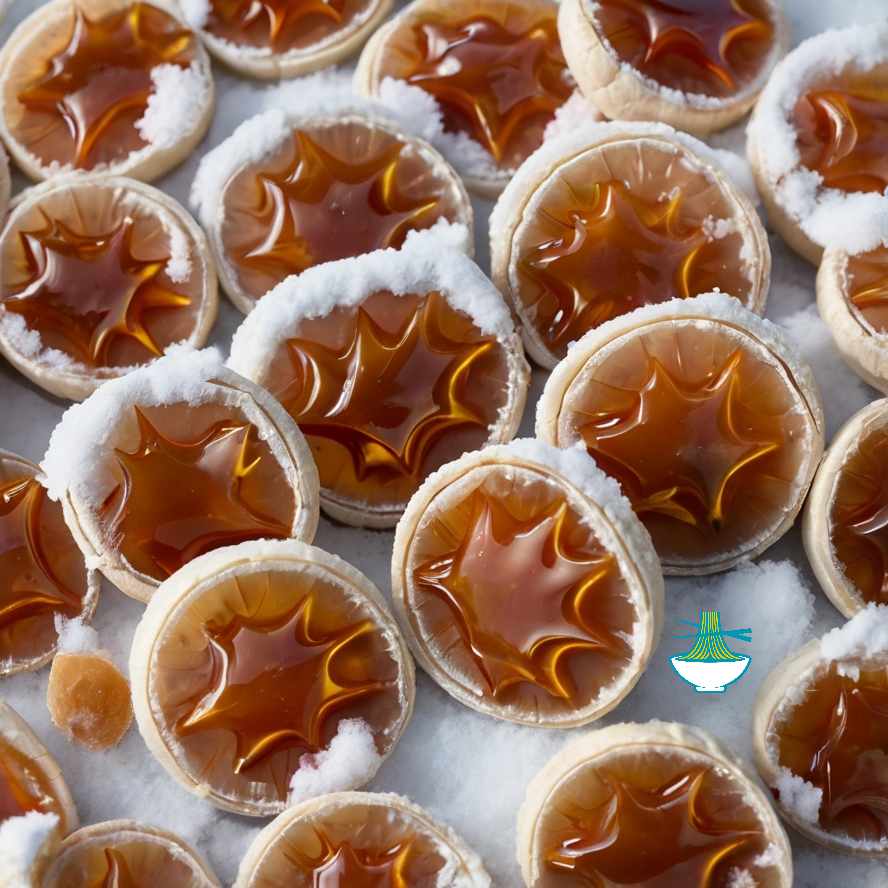Maple Taffy on Snow, or "Tire d'érable sur la neige," is a cherished Canadian treat enjoyed during the winter months. This sweet candy is made by pouring hot maple syrup over fresh snow or crushed ice, where it quickly hardens into a delicious, sticky confection. Often served on sticks or in bite-sized pieces, Maple Taffy on Snow is a popular feature at winter festivals and carnivals across Canada, offering a unique and delightful experience for all ages.

The tradition of Maple Taffy on Snow dates back to the early Indigenous peoples of Canada, who discovered that the sap of maple trees could be transformed into a sweet treat during the cold months. This practice was adopted and popularized by French settlers in Canada, becoming a quintessential part of Canadian winter celebrations. Today, it remains a beloved cultural symbol, reflecting both the historical significance and enduring charm of Canadian culinary traditions.
Ingredients:
- 1 cup pure maple syrup (preferably Grade A)
- Fresh, clean snow (or crushed ice as a substitute)
- Wooden popsicle sticks or chopsticks
- A large pot or deep saucepan
- A candy thermometer
Method:
1. Prepare Ingredients: Gather all necessary items, including a clean, flat surface for the snow or crushed ice.
2. Heat Syrup: Pour maple syrup into a large pot and heat on medium-high. Monitor the temperature with a candy thermometer until it reaches 112°C (234°F).
3. Prepare Snow: Spread a thick layer of clean, fresh snow on a flat surface.
4. Pour Syrup: Once the syrup reaches the correct temperature, remove it from heat and let it cool briefly. Pour a small amount of hot syrup onto the snow; it should harden instantly.
5. Form Taffy: Use a wooden stick to roll the hardened syrup into a lollipop or ball shape. Continue until all syrup is used.
6. Serve: Enjoy the Maple Taffy on Snow immediately while warm and gooey.
Notes:
- Use only pure maple syrup for optimal flavor and texture.
- Exercise caution with hot syrup to avoid burns, and keep children away from the stove.
- If snow is unavailable, substitute with crushed ice.

Nutrition Value:
Nutritional Information (per 1 tablespoon):
1. Pure Maple Syrup (Grade A)
- Calories: 52
- Carbohydrates: 13.1 g
- Protein: 0 g
- Fat: 0 g
- Sodium: 2 mg
- Cholesterol: 0 mg
- Vitamins: Small amounts of Vitamin B2 (Riboflavin)
- Minerals: Calcium (7 mg), Iron (0.1 mg), Magnesium (2 mg), Potassium (42 mg)
- Nutritional Benefits: Maple syrup is rich in antioxidants and contains essential minerals like manganese and zinc. It is a natural sweetener with a lower glycemic index compared to refined sugars. Its antioxidants may help combat oxidative stress.
2. Fresh, Clean Snow (or Crushed Ice)
- Calories: 0
- Carbohydrates: 0 g
- Protein: 0 g
- Fat: 0 g
- Sodium: 0 mg
- Cholesterol: 0 mg
- Vitamins: None
- Minerals: None
- Nutritional Benefits: Snow and crushed ice do not contribute any nutritional value. Their primary role in this recipe is to rapidly cool and solidify the maple syrup. Clean snow or ice ensures the safety and texture of the taffy.
3. Wooden Popsicle Sticks or Chopsticks
- Calories: 0
- Carbohydrates: 0 g
- Protein: 0 g
- Fat: 0 g
- Sodium: 0 mg
- Cholesterol: 0 mg
- Vitamins: None
- Minerals: None
- Nutritional Benefits: These utensils are used for handling and serving the taffy. They do not contribute to the nutritional content of the recipe but are essential for the proper enjoyment of the treat.
4. Large Pot or Deep Saucepan
- Calories: 0
- Carbohydrates: 0 g
- Protein: 0 g
- Fat: 0 g
- Sodium: 0 mg
- Cholesterol: 0 mg
- Vitamins: None
- Minerals: None
- Nutritional Benefits: The pot or saucepan is used for cooking the syrup but does not affect the nutritional profile of the taffy. Proper cookware ensures even heating and consistent results.
5. Candy Thermometer
- Calories: 0
- Carbohydrates: 0 g
- Protein: 0 g
- Fat: 0 g
- Sodium: 0 mg
- Cholesterol: 0 mg
- Vitamins: None
- Minerals: None
- Nutritional Benefits: The candy thermometer is a tool used to monitor the syrup’s temperature. It does not impact the nutritional content of the recipe but is crucial for achieving the correct consistency of the taffy.


Comments